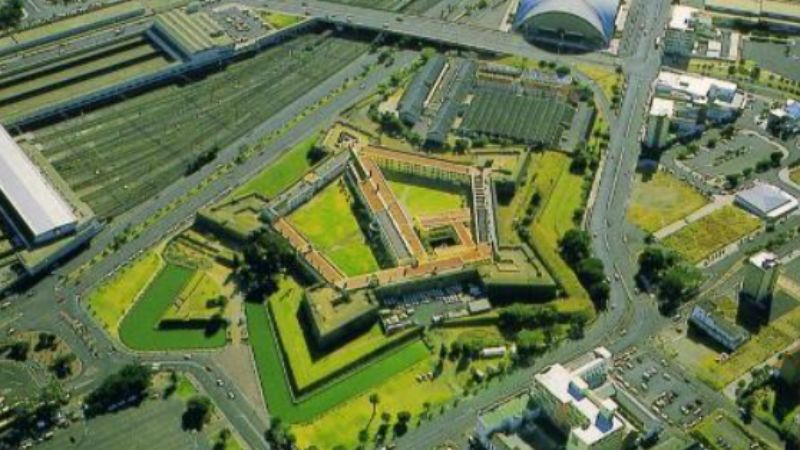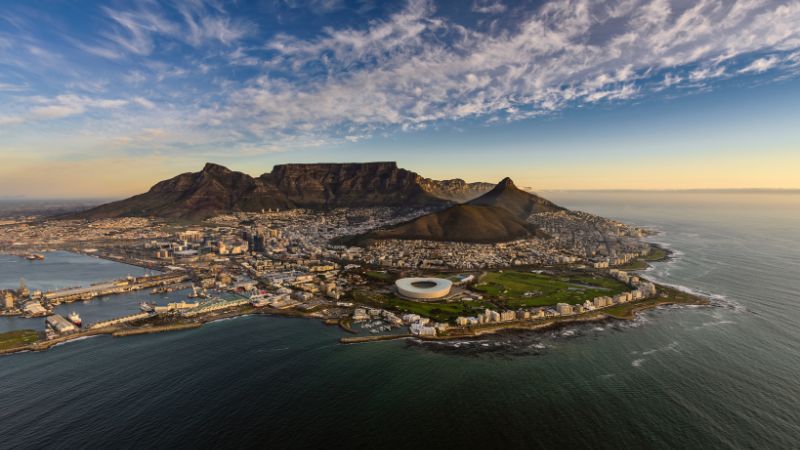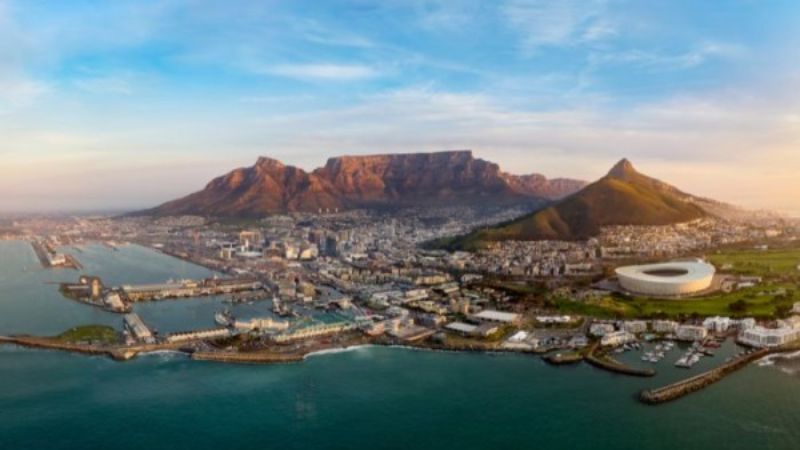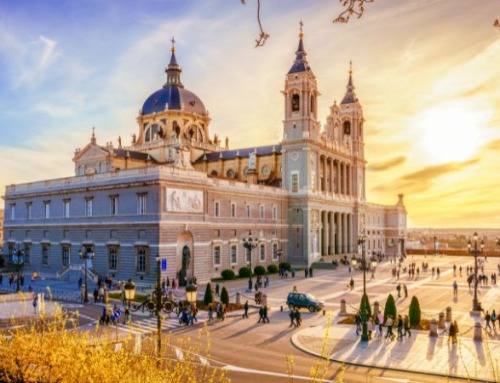Cape Town, tucked between the Atlantic Ocean and the majestic Table Mountain, is one of Africa’s most fascinating and culturally rich destinations.
The scenery in Cape Town is hard to beat. You’ve got long beaches, rolling hills, and cliffs that drop straight into the sea. Table Mountain is right in the middle of it all, with its flat top standing out from just about anywhere in the city.
The mountain is part of a protected national park and is packed with plant species you won’t find anywhere else. And while it’s great to hike, you can also take the cable car straight to the top for a view that covers the entire city and coast.
Around the mountain, the land opens up into neighbourhoods, parks, and a long coastline with quiet bays and golden beaches. On the other side, you’ll see False Bay and its smaller seaside towns that are perfect for a day trip.
The city itself stretches across a coastal plain that feels surprisingly open for its size. One moment you’re walking along a busy street, and five minutes later, you’re at a viewpoint with mountains behind you and ocean ahead.
But Cape Town isn’t just about landscapes. The city’s cultural scene and historical memory live on through its museums, galleries, and iconic landmarks—places like the District Six Museum, the Zeitz MOCAA, and the Castle of Good Hope. They each tell part of the story of a city shaped by resilience and change.
A City Built on Cultures
Cape Town’s history includes waves of colonisation, slavery, segregation, and resistance — and that shows up in the city’s everyday life, not just its monuments.
You’ll hear English, Afrikaans, isiXhosa, and more spoken in shops and taxis. On a single street you might find a halal butcher, a Portuguese bakery, and a Cape Malay eatery.
Bo-Kaap is one of the clearest examples of this history. Its colourful homes sit on steep cobbled streets, originally housing freed slaves from Southeast Asia and East Africa. Today it’s a stronghold of Cape Malay culture, where mosques, spice shops, and family-run food tours keep the local identity alive.
At Greenmarket Square, one of the oldest public spaces in the city, you’ll find musicians, street performers, and craft vendors from across the continent. While it’s popular with tourists, it’s still a working space where artists sell directly to the public — and where stories and jokes fly as fast as the haggling.
Zeitz MOCAA
The Zeitz Museum of Contemporary Art Africa (MOCAA) is one of the most important institutions for African artists on the continent.
Located inside a converted grain silo in the V&A Waterfront, the building itself is a feat of architecture. The original 1920s structure was carved into cylindrical atriums and concrete “tubes” by renowned architect Thomas Heatherwick. Parts of the industrial shell remain visible, giving the space a strong connection to the city’s port history.
Inside, the museum spans nine floors and more than 100 galleries. It showcases works by both emerging and established African artists — from sculpture and photography to installation art, performance video, and experimental media.
Rotating exhibitions highlight topics like identity, gender, migration, environmental change, and African futures. You’ll also find artist-in-residence programmes, educational workshops, and a rooftop terrace with panoramic views of the harbour and Table Mountain.
District Six Museum
The District Six Museum honours a neighbourhood that was destroyed during apartheid. Once a lively and diverse area near the city centre, District Six was known for its jazz clubs, corner shops, and shared backyards — where Black, coloured, and immigrant families lived side by side.
In 1966, the government declared it a “white-only” area under the Group Areas Act. Bulldozers followed. More than 60,000 residents were forcibly removed, their homes flattened, and their community scattered.
Today, the museum reminds us of that history. It’s housed in a former church and built around personal memory, with handwritten floor maps, family photos, and oral histories from residents who lost everything.
You’ll see not just artefacts, but the emotion of loss, resilience, and dignity. Some tours are led by former residents, who walk you through what was, and what was taken.
Castle of Good Hope
Built by the Dutch East India Company in 1666, the Castle of Good Hope is South Africa’s oldest surviving colonial structure.
It was originally a military outpost and supply station for Dutch ships on their way to Asia. Over time, it became a place of administration, punishment, and power. Its five pointed bastions and moat reflect classic Dutch military design, and its thick walls once held both soldiers and political prisoners.

Today, the castle hosts museums, exhibits, and rotating art displays. You’ll find the Military Museum, which covers colonial wars and the early history of Cape Town, and the William Fehr Collection, with paintings, furniture, and objects from the 18th and 19th centuries.
Visitors can watch ceremonial events like the Key Ceremony or explore hidden parts of the fort such as dungeons and old kitchens. The castle also looks out across modern Cape Town, making it a literal and symbolic crossroads of past and present.
Table Mountain
Table Mountain is part of everyday life in Cape Town — from weather reports to hiking plans to taxi directions.
It’s also part of the Table Mountain National Park, which protects over 1,400 plant species and several microclimates. The top is flat but wide, with trails leading to lookout points in every direction.

You can hike up through routes like Platteklip Gorge, India Venster, or Skeleton Gorge (which starts in Kirstenbosch Gardens), or take the aerial cableway — a rotating cable car that gives 360° views on the way up.
Once on top, you’ll find dassies (small mammals related to elephants), sunbirds, and even the occasional paragliding launch. It’s a popular place for watching sunsets or just getting away from the buzz of the city without going far.
Robben Island
Located just off the coast, Robben Island is one of the most important historical sites in South Africa.
Used for over 400 years as a place of isolation — from lepers to political prisoners — it became world-famous as the prison where Nelson Mandela was held for 18 years.
Today, it’s a museum and UNESCO World Heritage Site, offering ferry rides and guided tours that often include stories from former inmates.
You’ll visit Mandela’s cell, the exercise yard, and the limestone quarry where prisoners worked long hours in blinding heat. The island also has a village for staff, a small church, and views back toward Table Mountain that Mandela described as both hope and reminder.
Cape Point and Cape of Good Hope
These two landmarks sit inside Table Mountain National Park, about an hour and a half from the city. They’re not technically the southernmost point in Africa (that’s Cape Agulhas), but they are where the Atlantic and Indian Oceans meet.
Cape Point is known for its steep cliffs and historic lighthouse. You can walk the trail to the top or take the Flying Dutchman funicular — a short rail line that gets you most of the way there. The views are stunning, especially when the weather changes by the minute.
Cape of Good Hope, just 1.2 km away, is wilder and lower. It’s known for its rugged paths, wind-blown beaches, and wildlife. You might see baboons, ostriches, eland, and seabirds. There are also shipwreck trails and hidden picnic spots if you take the time to explore.
Boulders Beach
In Simon’s Town, just south of Cape Town, Boulders Beach is one of the few places in the world where you can walk beside a colony of wild African penguins.
The beach is named for the large granite rocks that break the wind and create calm tidal pools — ideal for swimming, especially for kids.

A raised boardwalk keeps visitors away from nesting areas but lets you get surprisingly close. The penguins wander across footpaths, nap in the bushes, and swim in the clear shallows.
They’re part of a protected colony established in 1982, and rangers are on hand to keep the environment safe for both penguins and people.
Kirstenbosch National Botanical Garden
The Kirstenbosch National Botanical Garden sits at the foot of Table Mountain and covers over 500 hectares of cultivated gardens, forest, and fynbos-covered slopes.
It’s one of the world’s top botanical gardens and focuses entirely on indigenous South African flora. Each section of the garden tells a story — from traditional healing plants to rare species under threat.

The Boomslang Canopy Walkway, a snaking bridge above the treetops, offers panoramic views of the mountains and gardens below. There’s also a nursery, restaurant, and open-air concert stage.
In summer, you can bring a picnic and enjoy live music against the backdrop of the mountain — a local tradition that combines nature and community.
Seal Island and World of Birds
Seal Island, located about 6 km off the coast of Hout Bay, is home to a massive colony of Cape fur seals. Tours to the island are short, affordable, and often include seabird watching and marine commentary. If you’re lucky and the season is right, you might also spot a dolphin or even a great white shark.
In Hout Bay itself, the World of Birds Wildlife Sanctuary is Africa’s largest bird park. It’s home to more than 3,000 birds across 400 species, plus monkeys, reptiles, and other small animals — many of them rescues.
It’s designed as a walk-through park, so you can wander through aviaries and animal enclosures at your own pace. It’s especially popular with families but has plenty to offer for animal lovers and photographers too.
Study Holiday in Cape Town with Astrolabio
Looking to improve your English while discovering one of the most unique cities in the world?
Our language programme with LAL School puts you right in the heart of Cape Town. The school is based in a lively, walkable area close to cafés, shops, restaurants, and the beach promenade.
You’ll take part in 15 hours of lessons each week, with friendly, qualified teachers who help place you in the right class based on your level. All learning materials and a certificate of attendance are included.
But the real magic happens outside the classroom.
You’ll join guided visits to Cape Point, Robben Island, Boulders Beach, Kirstenbosch Gardens, Seal Island, and more. There are also social evenings, swimming, group outings, and time to relax with new friends from around the world.
Cape Town has everything — dramatic landscapes, real history, and a welcoming atmosphere that makes it the perfect backdrop for a learning experience you won’t forget.
Want to know more? Get in touch and we’ll help you plan your study trip.




